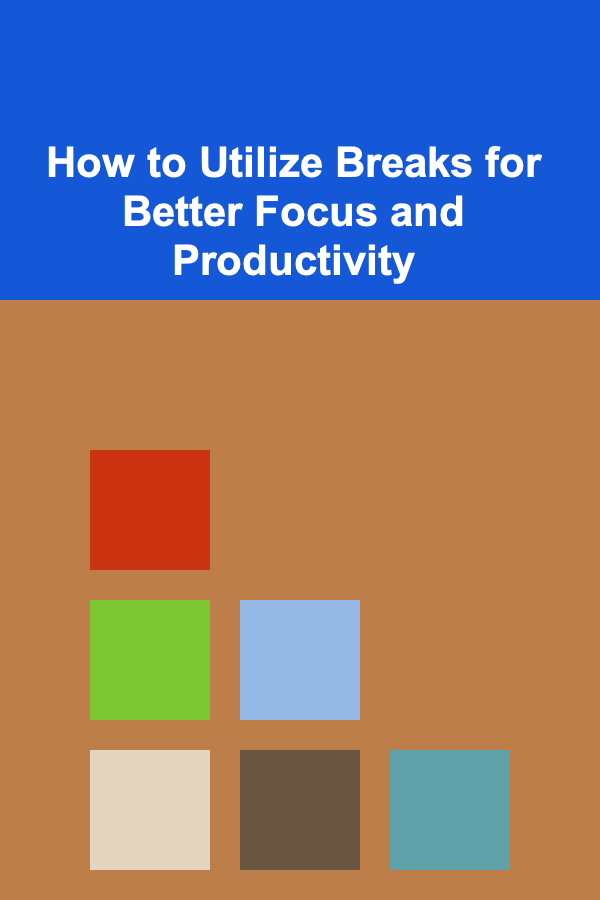
How to Utilize Breaks for Better Focus and Productivity
ebook include PDF & Audio bundle (Micro Guide)
$12.99$9.99
Limited Time Offer! Order within the next:

In an era defined by constant connectivity and relentless workloads, the significance of taking breaks cannot be overstated. Many professionals underestimate the power of a well-timed break, often pushing themselves to work longer hours under the misconception that continuous effort equates to increased productivity. However, research suggests that strategically utilizing breaks can enhance focus, improve cognitive function, and ultimately boost overall productivity. This comprehensive article will explore the science behind breaks, the types of breaks, how to integrate them into your workday, and strategies for maximizing their effectiveness.
Understanding the Science Behind Breaks
1.1. The Importance of Rest for Cognitive Function
Cognitive fatigue is a significant factor in reduced productivity and focus. According to neuroscience research, our brains operate best when given time to rest and recuperate. Continuous work can lead to mental exhaustion, resulting in decreased attention spans and impaired decision-making abilities.
Studies show that taking regular breaks improves focus and cognitive performance. For instance, a study published in the journal Cognition indicated that participants who took breaks performed better on tasks requiring sustained attention compared to those who worked continuously.
1.2. How Breaks Impact Creativity
Many people find that stepping away from a task or problem allows for fresh perspectives. This phenomenon, often referred to as "incubation," suggests that taking breaks can lead to enhanced creativity. A study in Psychological Science found that individuals who allowed their minds to wander during breaks were more likely to generate creative solutions to complex problems.
Types of Breaks
2.1. Microbreaks
Microbreaks are short breaks lasting anywhere from a few seconds to a couple of minutes. These breaks serve as brief pauses in work activities and can be as simple as stretching, standing up, or doing a quick breathing exercise. Microbreaks are effective in relieving tension and refreshing the mind without requiring extensive time away from tasks.
2.2. Short Breaks
Short breaks typically last between 5 to 15 minutes. These breaks allow for more substantial disengagement from work, enabling individuals to recharge mentally and physically. During short breaks, employees can step outside, grab a snack, or engage in light conversation with colleagues.
2.3. Long Breaks
Long breaks extend beyond 15 minutes and can include lunch breaks or extended periods designated for relaxation. These breaks are essential for restoring energy levels and promoting overall well-being. Taking long breaks can help reset the mind, allowing for improved focus upon returning to work.
2.4. Active Breaks vs. Passive Breaks
Active breaks involve engaging in physical activities, such as stretching, walking, or exercising, while passive breaks may include activities like watching videos or scrolling through social media. Research suggests that active breaks can lead to higher energy levels and improved focus when returning to work compared to passive breaks.
Identifying Your Break Needs
3.1. Recognizing Signs of Fatigue
Understanding your body's signals is crucial for determining when to take breaks. Common signs of fatigue include:
- Decreased concentration
- Increased irritability
- Physical tension (e.g., headaches or muscle stiffness)
- Diminished motivation
Being aware of these signs can help you proactively incorporate breaks into your routine before burnout sets in.
3.2. Understanding Your Work Style
Recognizing your individual work style is key to determining the frequency and duration of your breaks. Some individuals thrive on shorter, more frequent breaks, while others may prefer longer periods of focused work followed by extended breaks. Experimenting with different break schedules can help you discover what works best for you.
Integrating Breaks Into Your Workday
4.1. Scheduling Breaks
One effective way to ensure you take breaks is by scheduling them into your workday. Treat breaks as appointments you cannot miss, setting reminders to prompt you to step away from your desk. Consider the following tips:
- Use Calendar Tools: Block off time in your calendar for breaks to create a structured routine.
- Prioritize Breaks: Avoid the temptation to skip breaks, even when busy. Recognize their importance for maintaining productivity.
4.2. Utilizing the Pomodoro Technique
The Pomodoro Technique is a popular time management method that incorporates structured breaks. The technique involves working for 25 minutes, followed by a 5-minute break. After completing four "Pomodoros," take a longer break of 15-30 minutes. This approach promotes sustained focus while ensuring regular intervals for rest.
Maximizing the Effectiveness of Breaks
5.1. Activities to Engage In During Breaks
The type of activity you engage in during breaks can significantly impact their effectiveness. Here are some suggestions:
- Physical Activity: Take a short walk, do yoga stretches, or perform quick exercises to reenergize your body.
- Mindfulness Practices: Engage in deep breathing exercises or meditation to clear your mind and reduce stress.
- Social Interaction: Use breaks to connect with colleagues or friends, fostering positive relationships and enhancing your mood.
- Nature Exposure: If possible, step outside to enjoy fresh air and natural scenery, which can help improve mood and focus.
5.2. Mindfulness and Relaxation Techniques
Incorporating mindfulness techniques during breaks can enhance their effectiveness:
- Breathing Exercises: Engage in deep, slow breaths to calm the mind and body.
- Guided Meditation: Use apps like Headspace or Calm for short guided meditation sessions during breaks.
- Progressive Muscle Relaxation: Tense and relax different muscle groups to release physical tension.
These practices can promote mental clarity and emotional well-being.
Creating a Break-Friendly Environment
6.1. Setting Up Your Workspace
Your workspace plays a vital role in encouraging effective breaks. Consider the following tips:
- Create a Designated Break Area: If possible, establish a separate space for taking breaks, free from work-related distractions.
- Keep It Comfortable: Ensure that your break area is inviting and comfortable, making it easier to unwind.
- Limit Distractions: Remove any work-related materials from your break area to create a clear boundary between work and rest.
6.2. Designing Common Areas for Breaks
If working in an office environment, consider the layout and design of common areas intended for breaks:
- Collaborative Spaces: Encourage social interaction by creating spaces that facilitate conversation and connection among coworkers.
- Quiet Zones: Provide tranquil spaces for individuals seeking solitude during breaks, equipped with comfortable seating and calming decor.
Designing break-friendly environments cultivates positivity and encourages regular breaks.
Common Mistakes When Taking Breaks
While breaks are beneficial, certain mistakes can hinder their effectiveness:
- Overindulging in Passive Activities: Spending breaks entirely on social media or mindless browsing can leave you feeling drained rather than refreshed.
- Skipping Breaks: Ignoring the need for breaks in favor of extended work can lead to burnout and decreased productivity.
- Returning Too Quickly: Rushing back to work immediately after a break can prevent you from fully recharging.
Being aware of these common pitfalls can help you optimize your break experience.
Case Studies: Successful Break Strategies
Case Study 1: Google
Google is known for its innovative workplace culture, which emphasizes the importance of breaks. The company offers various amenities, including nap pods and wellness rooms, encouraging employees to take breaks when needed. This approach has contributed to high employee satisfaction and productivity levels.
Case Study 2: Buffer
Buffer, a social media management platform, follows a four-day workweek model. This structure allows employees to focus on their tasks while providing ample time for breaks and personal interests. As a result, Buffer reports high levels of employee engagement and work-life balance.
These case studies highlight the effectiveness of strategic breaks in enhancing workplace satisfaction and productivity.
Conclusion
Utilizing breaks effectively is essential for enhancing focus and productivity in today's fast-paced work environment. By understanding the science behind breaks, recognizing individual needs, and integrating structured break schedules, you can create a sustainable work routine that fosters well-being and performance.
Incorporating active and mindful activities during breaks, designing break-friendly environments, and learning from successful case studies further solidifies the value of taking breaks. Remember, breaks are not merely a luxury; they are a vital component of productive work life. Embrace the power of breaks, and watch your focus and productivity soar.
Reading More From Our Other Websites
- [Home Renovating 101] How to Maximize Storage in Your Home Renovation
- [Home Maintenance 101] How to Prevent Basement Waterproofing Issues with Regular Gutter and Downspout Cleaning
- [Home Staging 101] How to Stage Your Home to Create a Sense of Space
- [Horseback Riding Tip 101] First Ride Essentials: A Step-by-Step Guide to Mounting and Dismounting
- [Home Soundproofing 101] How to Quiet Noisy Pipes: Soundproofing Tips for Bathroom and Kitchen
- [Home Pet Care 101] How to Prevent Pet Heatstroke in Apartment Living: Essential Summer Tips for Urban Pet Parents
- [Personal Finance Management 101] How to Determine the Best Personal Finance Management Tools for Your Needs
- [Home Holiday Decoration 101] How to Create a Festive Atmosphere with Minimalist Holiday Decor
- [Home Maintenance 101] How to Maintain Your Home's Landscaping During All Seasons
- [Organization Tip 101] How to Use Crowdfunding Platforms for Charitable Causes

How to Build a Strong Email Marketing Campaign for Online Sales: A Comprehensive Actionable Guide
Read More
How to Choose the Right Color Palette for Your Renovation
Read More
How to Design a Spring Cleaning Checklist for Your Bedroom
Read More
How To Give Difficult Feedback with Grace
Read More
How to Plan a Family Karaoke Night at Home
Read More
How to Succeed in Phone Interviews: A Comprehensive Guide
Read MoreOther Products

How to Build a Strong Email Marketing Campaign for Online Sales: A Comprehensive Actionable Guide
Read More
How to Choose the Right Color Palette for Your Renovation
Read More
How to Design a Spring Cleaning Checklist for Your Bedroom
Read More
How To Give Difficult Feedback with Grace
Read More
How to Plan a Family Karaoke Night at Home
Read More